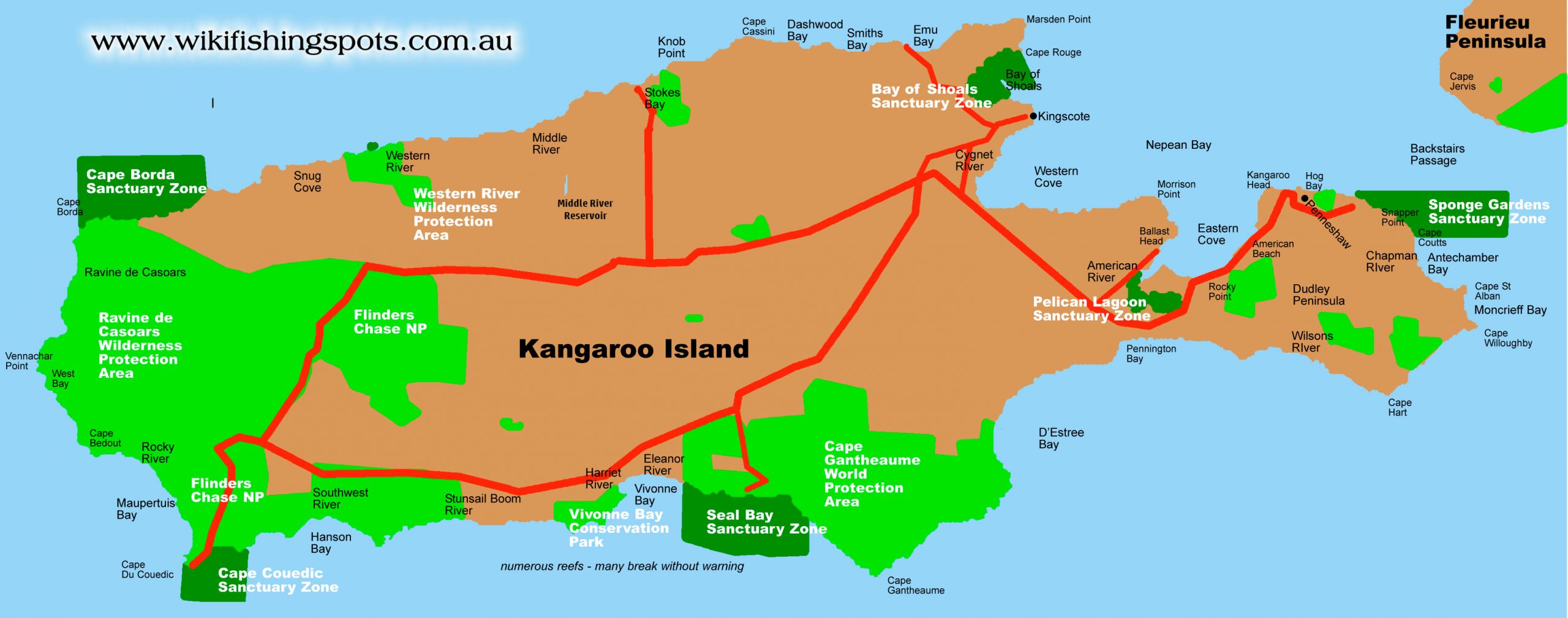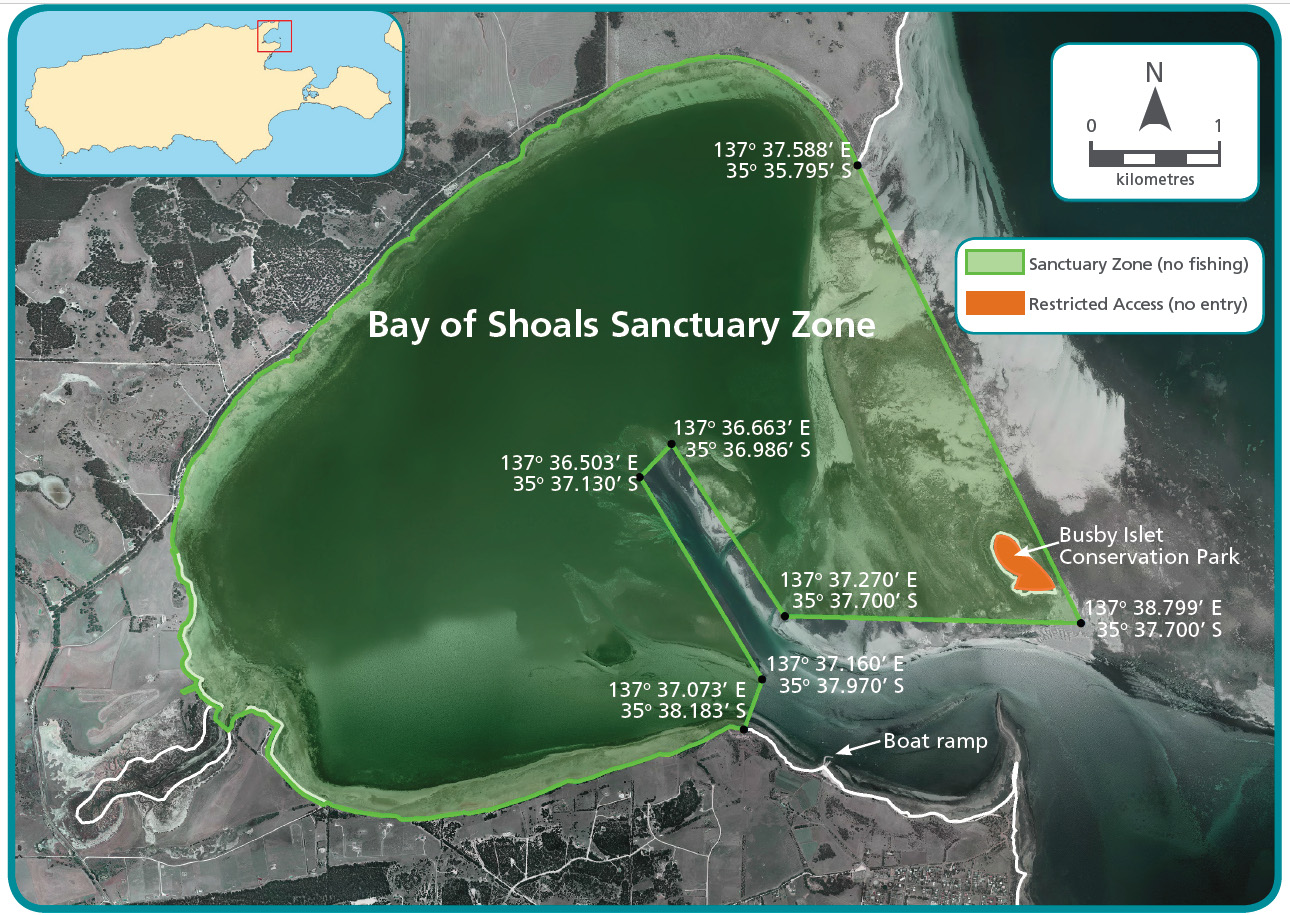
Kangaroo Island’s variety of marine habitat, and proximity to Adelaide, make it one of South Australia’s best fishing holiday destinations.
The island is nearly 150km in length from east to west and 55km from north to south, forming about 540km of coastline.
The north side of the island is effectively its lee shore and contains the most sheltered bays and inlets, with the more rugged coast on the southern and western sides facing the brunt of the Southern Ocean.
Backstairs Passage, between the island and Fleurieu Peninsula, is only 14km across, but becomes extremely rough and is no place for unsuitable boats or inexperienced skippers.
It is an 18km sea run from Cape Jervis on the mainland to Penneshaw.
Boaters who leave from Yorke Peninsula face a 60km run across Investigator Strait.
The north-east side of the island has sheltered coastal waters for safe family boating, and there are many jetty, estuary, surf and rock fishing spots.
There has been historically good trout fishing in Middle River and a reservoir.
A car or bicycle is needed to explore the island.
There is a regular vehicular ferry service from Cape Jervis to the island’s Penneshaw township.
While the island only has a relatively small tidal range, tidal currents make Backstairs Passage very rough if there is any wind.
The island has good facilities, including plenty of accommodation, campsites and boat hire, but book ahead.
Most visiting fishos chase bread and butter species, with king george whiting, tommy ruff, mullet, flathead, salmon trout, squid, snook and blue crabs forming the bulk of the catch.
There is good bream fishing in some of the tidal rivers, but with an abundance of small bream.
flathead and flounder are found off the low energy beaches and on sheltered estuary flats.
Kingfish can turn up unexpectedly, along with snapper, gummy and school sharks, and large rays.
Those who go wide catch crayfish, nannygai, queen snapper, school sharks, pink snapper, sweep, samson and more.
Occasionally caught are harlequin fish, blue morwong and bluethroat wrasse.
Sand crabs are common in the shallows at times, best in the warmer months.
Pest species can be a problem, including picker bream, fiddler rays, Port Jackson sharks, skate and shovelnose rays.
Penneshaw
This town on the north-east coast hosts the ferry service.
It has a jetty that fishes well for tommy ruffs, salmon trout, flathead, squid, garfish and snook.
The boat ramp is a good base for fishing anywhere between American Beach and Cape St Albans.
There is a rocky shoreline near the boat harbor entrance where landbased fishos catch whiting, squid, flathead, trevally, mullet and tommy ruffs.
Hog Bay has the ferry jetty.
The bay produces spotted whiting, silver whiting, snook, gar, tommy ruff, salmon trout, sand crabs and squid, and the jetty is a great fishing spot.
The breakwater is good for salmon, whiting, tommy ruffs, sharks and occasional kingfish, with mullet, flathead and salmon from the beach.
Back in the boat again, the cliffs east of Hog Bay hold reef species such as sweep, nannygai and snapper, while the sandy bays produce large squid whiting, snook, salmon and gar.
The region south of Cape Coutts, outside the marine sanctuary, has bluewater species such as nannygai, snapper, school sharks and kingfish, but being part of Backstairs Passage, strong currents run and good weather is required to fish these regions.
At the island’s eastern extremity, kingfish can be expected at Cape Willoughby, with suitable gear and care required to fish from the high platform.
Antechamber Bay
This bay is 15km east of Penneshaw near the eastern end of the island.
It is known for quality whiting.
Chapman River runs into Antechamber Bay and has mostly small black bream, salmon trout and mullet.
Yelloweye mullet can be caught from the beach, usually best in autumn/winter.
American River
The waters here are the most sheltered on the island, suited to smaller boats, but a marine sanctuary prevents fishing in the southernmost estuary.
Whiting, salmon trout, squid, garfish, snook, tommy ruffs, flathead and sand crabs can all be caught.
January to May is usually best for fishing the rough bottom.
Within the shallow inlet the rising tide fishes best, and the waters of Eastern Cove, between American River town and Kangaroo Head, produce whiting on the last two hours of the run-in tide.
American River jetty has salmon trout, whiting, tommy ruff, garfish and mullet.
There is rough bottom from Island Beach to Kangaroo Head, with whiting, snook, tommies, gar squid and flathead.
Snapper are best from November to May (SA restrictions currently apply).
Rocky Point, on the central southern Eastern Cove, produces snapper and whiting less than 1km offshore over broken bottom.
Kingscote
This is the biggest town, located in the west of Nepean Bay, and it has easy boat, jetty and shore fishing.
Whiting, flathead, salmon trout, squid, garfish, red mullet and sand crabs and more can be caught by boat from the edges of the channel in the Bay of Shoals.
There is strong tidal current through the channel.
Sand crabs are caught in drop nets.
At the east end of the spit are beacons that indicate the width of the spit.
Most of the Bay of Shoals outside the channel is a marine sanctuary.

Landbased fishos need not look further than the Kingscote boat ramp region at high tide for good fishing.
The town jetty is the longest on the island, and sometimes described as one of the best fishing jetties in South Australia.
It produces whiting, snook, tommy ruff, squid, garfish, trevally, couta, salmon trout, rays, sharks, leatherjackets and kingfish.
Spotted whiting are often caught at night. Snook and squid are also best at night.
A small jetty to the north has mostly squid, whiting, tommy ruff and snook.
D’Estree Bay
D’Estree Bay is about 40km from Kingscote.
It is a great beach fishing location, but only with 4WD launching for boats, and that’s when there is no seaweed carpet.
Rough ground near shore produces whiting, tommies, flathead, salmon trout and salmon trout.
A spot 2.5km out from black stones on the shore features deep, reef areas with snapper, trevally, whiting, sharks and even nannygai.
Snook are caught from April to September, with gar and squid all year.
At the south end of the bay lies Point Tinline, with Wreckers Beach nearby producing whiting, salmon, trevally, tommies, flathead and mullet, with sharks and rays mostly at night.
At low tide the holes near reef and weed areas can be fished from shore.
Further along is Wheatons Beach, with similar fishing.
Sower Bay has rough bottom and can be reached by 2WD, it has garfish, salmon, whiting, squid, tommies and flathead.
Vivonne Bay
This large bay has beach, river, jetty and rock fishing, but no boat ramp.
The beach near the Harriet River mouth has salmon, mullet, tomm ruff, sharks, flathead and bream.
The jetty has tommy ruff, whiting, squid, gar and trevally. The tommies are best at night.
Both the Harriet and Eleanor Rivers both have bream.
The Harriet estuary is shallow, with the river mouth channel running through seagrass flats.
There is a rough launch site that is weather dependent.
There is camping is along the Harriet River.
Point Ellen has salmon, trevally, sweep, leatherjackets and tommies, but rock fishing here requires great care.
Hanson Bay
The beach at the entrance to South West River is quite sheltered, and has tommies, salmon trout and mullet.
Whiting can be caught at night.
Bream are caught in the river and around the mouth when it is open.
To the east is a surf beach with salmon, mullet, mulloway school and gummy sharks.
West of the river the rocks produces big fish, including blue groper, but it fishes well because it is a long walk and can only fished safely when there is little or no wind.
There is a rough launch site.
Cygnet River
This river is always open to the sea.
It is the most reliable island river for big bream – fish the last hour of the rising tide, or early morning or evening.
Fish lightly weighted or unweighted baits or tiny lures on light tackle, with night fishing best for the big fish.
Emu Bay
This bay has a boat ramp and may provide a calmer alternative to the Bay of Shoals if the wind is blowing the wrong way.
There is a jetty and low-energy beach.
Stokes Bay
The launch site here is more exposed than those previously mentioned, but the species mix expands into crayfish and more.
Snug Cove
The waters off Snug Cove are hard to reach by boat but they produce large fish, including whiting, snapper, nannygai, morwong, trevally and even samson fish.
The nearest proper launch site is Emu Bay. There is a rough boat ramp at Stokes Bay, but a narrow reef entrance must be negotiated.
Snug Cove is a useful anchorage except when north or north-westers blow hard.
Western River
This estuary has good bream, as well as salmon trout and mullet.
Boats can usually leave the estuary and fish the reefy area outside.
Upstream in the river there are fishable snags.
Middle River
A good estuary, with surf and rock fishing at the river mouth.
Upstream are snaggy areas, with reefy patches out the front producing salmon and trevally.
The freshwater section has trout, as does the Middle River Reservoir.
Flinders Chase National Park
This park is at the wild western end of the island.
There are some superb beach and rock fishing spots here, set in spectacular scenery and amid abundant wildlife.
The surf beaches usually have deep holes and gutters where big salmon, tailor and mulloway are caught.
Enjoy camping with kangaroos, emus, koalas, wild geese and more.
West Coast rivers
There are four rivers. The mouths can be reached on foot.
A couple of the rivers have campsites.
She surf fishing is good, with bream in the rivers, although they are mostly small.
Expect salmon, tailor and mulloway in the surf.
West Bay
Some good remote-area rock fishing here, but take care.
Here is a list of recommended tackle for SA waters.
Here is the SA seasonal fishing calendar for various fish species.
Kangaroo Island boat ramps
Kangaroo Island coastline on Beachsafe
Kingscote tides
Kangaroo Island national parks PDF
SA fishing regulations
SA marine parks
NOTE: Special snapper rules apply in South Australia – more info here.
Email corrections, additions, pictures or video here.
